Jerez the Region
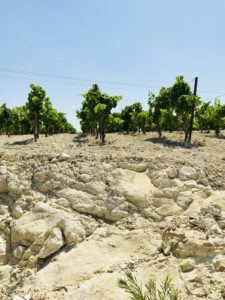
The white Albariza soil of Jerez
Jerez is located in Southern Spain in the Provence of Andalusia. Jerez is the name of the city that gives it’s name to the style of wine Marco de Jerez is the official designation of the region . Jerez is a 15 minute drive inland for the Atlantic Coast. The wine region is made up of the “Sherry Triangle” this being the cities of Jerez -Largest and most inland- El Puerto de Santa Maria- on the coast & Sanlucar de Barrameda- also on the coast. The region is made up of rolling hill covered with powdery white and I mean really really white chalk soil called albariza. The hills are a patchwork of albariza soil with arena (sandy) and barro (clay) mixed in. The most prized vineyards are the albariza, on the patchwork that is not this they will plant food corps or hay. Vineyards are not square and measured off, instead the roads and paths divide the different soils and agricultural products planted on them. These are not steep vineyards but more rolling hills between valleys coming up for the sandy beaches off of the Atlantic.
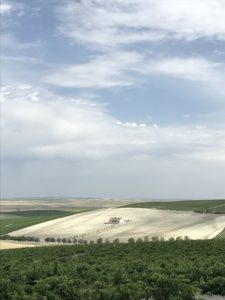
Grand Cru Vineyard
The region has two very important winds that impact the grape going in this area dramatically. The Poniente comes for the West off of the Atlantic Ocean and is cool and moist. This wind helps to regulate the temperature in the vineyards and in the cellars. The other wind the Levante is dry and very hot blowing over for the Sahara Dessert. These two wines balance each other out in the vineyards. The area only gets rain between October and April however the albariza soil works like a sponge and for the most part regulates the water supply for the vines through out the Summer in the dessert like growing area.
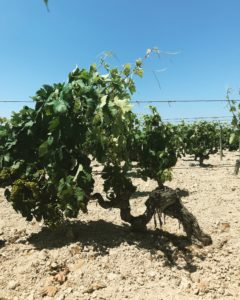
Palomino Fino Vines
The History
The area around Jerez has been planted with vines for at least two thousand years. Columella the famous agricultural author of Roman era even mentions classifications of the vineyards of Jerez. The region has historically be one worth fighting over as the and was settle by a long list of the most groups of people. This list includes the Carthaginians -expert farmers, the Greeks- great viticulturists, the Romans- they liked to drink- then came the Vandals & Visigoths -lots of fighting. Then the Moorish took it from the Vandals & Visigoths bringing the art of distillation to Spain. Then came the Reconquest when the christians kicked out the muslims and in 1492 Andalusia and the rest of Spain was back to christian rule. Amazingly though out all of this war and fighting the region continued to make and export wine. The history of the wines made in the area is as complex as the people who have ruled it. At one point in time the highest qualified “Grand Cru” vineyards produced some of the worlds most sought after and expensive wines. Columbus even departed for America from the ports of Jerez. Layers of religion, war & riches have made this an extremely complicated and interesting wine region. Everyone leaving a mark on the area and it’s wines. The wines of the region in modern times have been more focused on large production and lost sight of the Grand Cru status they once had in the world. A handful of family wineries, scholars and and nerds are working to change that. These wines are delicious and have a rich history.
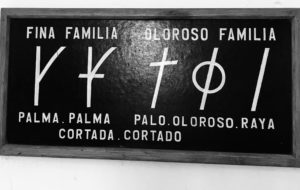
Traditional markings to show style
The wine styles
Very few wine regions in the world have as many styles of wine or as complicated production methods as Jerez. Here is a little cheat sheet to the styles of the area.
Dry Sherry
Manzanilla, Fino (Flor)
Dry to Medium Sherry
Amontillado, Oloroso, Palo Cortado (Oxidative)
Naturally Sweet Sherry
Moscatel, Pedro Ximénez (Dried grapes)
Sweet Sherry/Blended
Pale Cream, Medium,Cream (Blend of the above styles)
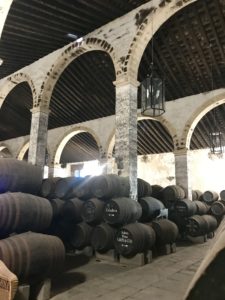
Bodega
What is Flor? It is a blanket of yeast that forms on the top of biologically aged Sherry this protects the wines and keeps them from oxidizing. The Flor is a living breathing yeasty creature; it requires perfect conditions to thrive. These conditions are very often the cool cellars along the coast in Sanlucar de Barrameda where this style wine is call Manzanilla & El Puerto de Santa Maria (where it is called Fino) inland in the city of Jerez this style is also made and called Fino. It is however a more most commonly from the cooler coasts with the salt air seeping into the cellars that the flor is happiest and the most elegant examples of biologically aged wines are made.
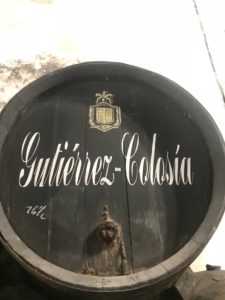
Barrels are used to age all styles
What is Oxidative aging? This is when the the wine in the barrel is exposed to oxygen. This cause the wine to oxidize giving it a nutty flavor, intensifying its color and concentrated the alcohol by evaporation.
One of the great things about Sherry is the blending and the aging process. The wines are stored in a “criaderas y soleras” this is essentially a stack of barrels that are topped with fresh wine at harvest and the then the other wines are moved down in the stack. The wines are then bottles from the barrels at the bottom of the cridera.
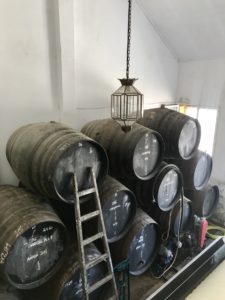
The Solera
My favorite things to serve with Sherry:
Dry aged steak & Oloroso
Grilled shrimp & Manzanilla
Slami & Amontillado
Olives & Almonds & Fino
Wines to try or visit if you can-
Bodegas Tradiction
Bodegas Grant
Fernando de Castilla
Gutierrez-Colosia
Cota 45
El Maestro Sierra
Places to EAT!
La Taberna del Chef del Mar Calle Puerto Escondido, 6, 11500 El Puerto de Sta María – This place is hip and modern and only makes seafood! Really really good seafood. Get the whole fried fish if they offer it! Calle Puerto Escondido, 6, 11500 El Puerto de Sta María
La Carbona Calle San Francisco de Paula, 2, 11401 Jerez de la Frontera- Amazing place in and old bodega with fabulous grilled meats and a great wine list.